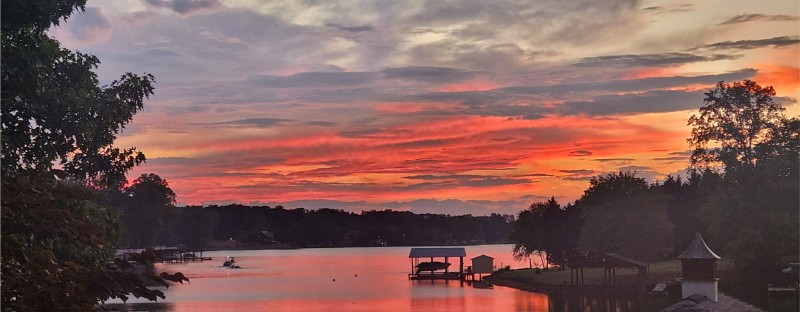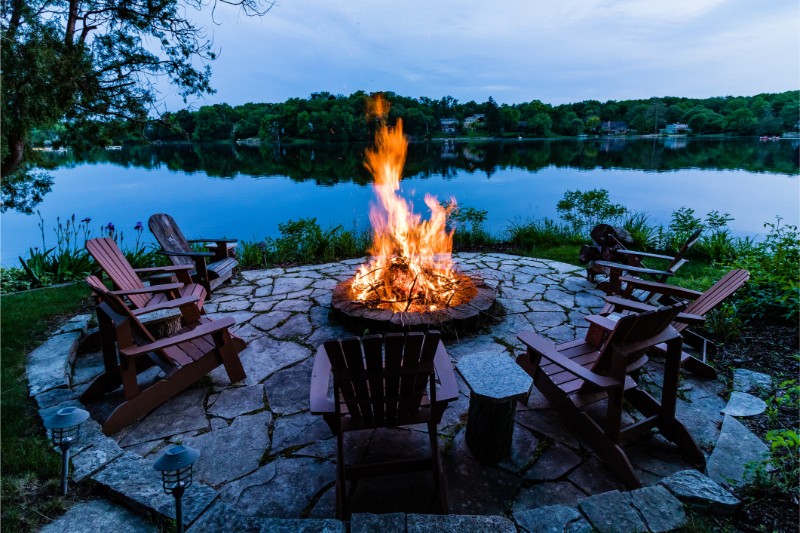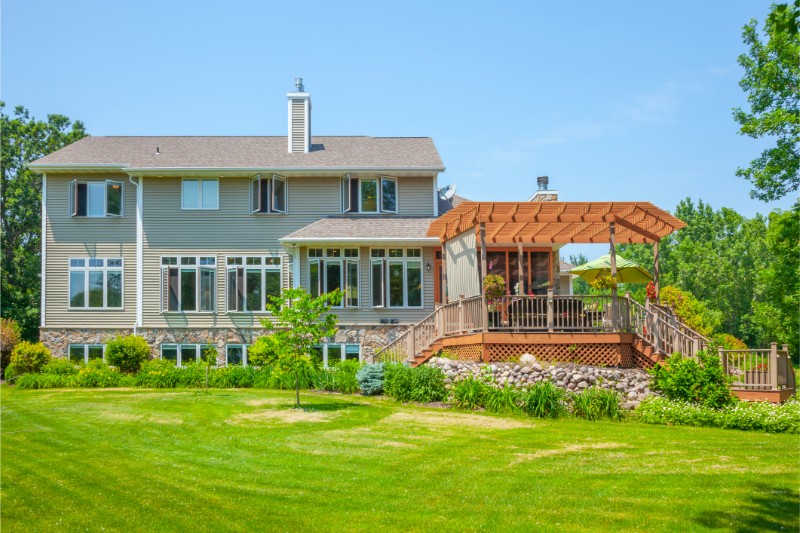Design tips for maximizing your Smith Mountain Lake waterfront views

Nothing beats owning a waterfront home at Smith Mountain Lake. Whether you’re a full-time resident or this is your second home, you’ll know that living and owning real estate here means enjoying a lifestyle that blends tranquility with endless opportunities for outdoor recreation.
And then there’s the view! But to fully enjoy the lake’s many lovely vistas—from the sun gilding the water at sunrise to golden hour glows—your home should be designed to take full advantage of its enviable location.
Let’s take a look at the many ways you can ensure that you’re always looking out at something beautiful. Through thoughtful architecture and interior design, smart landscaping, and curated outdoor spaces, you can enhance your lakefront lifestyle and boost your home’s value at the same time.
Table of Contents:
Architectural and Interior Design Elements
The right real estate design choices can turn any waterfront Smith Mountain Lake home into a retreat with a front-row seat to the “Jewel of the Blue Ridge Mountains.” A well-designed home draws the eye outward, anchors one’s connection to the landscape, and lets the lake take center stage.
- Strategic Window Placement
Windows are your biggest ally when it comes to capturing lake views. Floor-to-ceiling glass, panoramic windows, or multi-panel sliders can flood interiors with natural light and dissolve the boundary between indoors and out. Consider placing windows not just along the lakeside, but on perpendicular walls to allow angled views of the water from deep within the home.
In key living areas—such as the kitchen, primary suite, or great room—use window groupings to layer views at different heights and perspectives. Transom or clerestory windows, which are above eye level, can bring in additional light and sky views without compromising privacy.
- Open Floor Plans with a Purpose
An open layout does more than just make a home feel airy—it also supports uninterrupted sightlines. Stay away from solid furniture arrangements or unnecessary room dividers. Instead, opt for low-profile furnishings, open shelving (but don’t clutter up those shelves), or glass-front cabinets to maintain visual flow.
If you have a multi-level home, think about an open staircase or glass-panel railings. These will allow light and views to travel vertically between floors.
- Make an Arresting First Impression
Build anticipation with a well-placed front door or entryway, and deliver drama the moment someone enters. Think of the entry as a viewfinder: a clear line of sight to the water that’s framed by the architecture of your home. You can help establish that visual connection instantly through the use of a glass front door, open breezeways, or straight-through entry halls.
- Elevated Decks and Patios
Because Smith Mountain Lake’s terrain can vary from gently sloping to steep, tiered or cantilevered decks can help overcome elevation challenges and create vantage points that feel expansive—and all without the need for a major excavation. Multi-level outdoor spaces that are connected by wide stairs or stepped planters allow you to experience the lake from different elevations.
To maintain the expansiveness of the view, consider frameless glass railings or thin stainless-steel cable systems. Bonus: these materials often require less maintenance than traditional wooden balusters.

- Roofing That Lifts the Eye
Rooflines influence not just how your home looks from the outside but how it feels inside. Shed-style and butterfly roofs angle upward, guiding sightlines out. On the road-facing side, incorporate clerestory windows beneath the roofline to invite more daylight in. If you have a sloped lot, a reverse walkout design (where the main living area is above the entry) can still give you elevated views even if your property is set back from the shoreline.
- Let the Lake Be Your Focal Point
When your main feature is already outside, design with restraint. Stick to neutral, organic palettes indoors—whites, woods, soft greys, or lake-inspired blues and greens. They complement the scenery rather than distract from it.
Fireplaces, statement lighting, and art should support, not compete with, the view. You can also place mirrors opposite windows to reflect lake scenes deeper into the home.

Low-growing buttonbush is native to the Smith Mountain Lake area.
Landscaping for Unobstructed Views
As with your architectural and interior design elements, landscaping should be about framing, not fighting, the view. The following strategies work well with the local environment while aligning with AEP Shoreline Management regulations and local zoning guidelines.
- Use Native Plants and Low-Profile Landscaping
Stick to low-growing native plants such as buttonbush as well as ornamental grasses that blend well with the natural environment and require less upkeep. Avoid tall shrubbery near the shoreline that may obstruct the view, whether from patios, decks, or interior spaces.
- Terraced Landscaping
Terracing is a beautiful and practical way to manage sloped waterfront lots. (As previously mentioned, the elevation of Smith Mountain Lake real estate does vary.) With strategically placed stone retaining walls or planters, you can prevent erosion while creating visually appealing layers that lead the eye toward the water.
- Clear Visual Pathways
Prune trees and limb up taller varieties to frame rather than block the view. When possible, keep key sightlines clear between seating areas and the shoreline. You can also use landscaping to guide the eye and movement: paver paths, meandering stone walkways, or steps that lead naturally toward the dock or lake-facing patio.
- Create a Focal Point with Docks and Sitting Areas
Design your dock or lakeside seating area as a destination. Whether it’s a simple bench, a covered pergola, or a firepit by the water, these intentional outdoor spaces invite you to spend more time lakeside while anchoring your view.
Outdoor Living Spaces
Speaking of outdoor spaces, this is another area you will want to focus on when your goal is to maximize your home’s views. Functional, well-placed outdoor spaces also make your property more livable—and more valuable.
To start with, create an indoor-outdoor flow that feels seamless. Slide-away glass walls, accordion doors, and screened porches with disappearing panels blur the line between interior and exterior. Use consistent flooring materials or colors between inside and outside to extend the visual footprint of your home toward the water.
Outdoor living zones should be positioned like rooms—a lounge here, a dining nook there—with just enough structure to feel intentional, but open enough to keep the focus on the lake.
- Lakeside Lounges and Fire Pit Areas
There’s nothing like an evening spent by the fire with the lake shimmering nearby. A fire pit surrounded by Adirondack chairs or a stone bench can become a natural social hub. This is why you want to place seating where people naturally gravitate, whether it’s near the shoreline, beside the dock, or nestled into a terraced nook.

- Outdoor Kitchens and Dining Spaces
Think beyond the grill. A built-in counter with prep space, a pergola for shade, and a dining table with a view makes lakeside meals feel like a resort experience. Use natural materials—stone, wood, and powder-coated metal—that can withstand weather while blending with the scenery.
- Water-View Pools and Hot Tubs
If your property permits it, placing a hot tub or plunge pool overlooking the lake adds a layer of luxury without blocking views. Use natural stone decking or border plantings to help the space feel more integrated into the landscape.
- Strategic Outdoor Lighting
One of the most-overlooked elements, lighting can instantly change how one perceives a space. That said, you don’t want your house to be a disco ball on the water. Use low-voltage or solar lighting to softly illuminate pathways, highlight landscaping, and add ambiance to seating and dining zones—all while preserving the lake’s peaceful atmosphere after dark.
- Blending Hardscaping and Softscaping
Remember that the most successful outdoor designs integrate hard surfaces (patios, retaining walls, paths) and soft elements (plantings, grass, natural stone) in a way that feels organic.

Stay Shoreline Smart: Local Regulations to Keep in Mind
Before breaking ground on that dream deck or trimming trees for a better view, it’s important to understand that lakefront properties at Smith Mountain Lake are subject to specific regulations. These rules are in place to preserve the natural beauty of the area and to ensure that the shoreline remains safe, accessible, and ecologically balanced.
Appalachian Power Company (AEP) Shoreline Management Rules
Smith Mountain Lake is part of the Smith Mountain Project, a hydroelectric initiative operated by Appalachian Power Company (AEP). Because of this, AEP oversees much of the shoreline and enforces a Shoreline Management Plan (SMP) that regulates what property owners can and cannot do within the Project Boundary—a designated zone that includes the lake and surrounding land immediately adjacent to the water.
If your plans involve any activity near the water—such as building or modifying a dock, clearing vegetation, or stabilizing your shoreline—you’re likely operating within this boundary and will need prior approval from AEP.
Here’s what typically requires a permit under the SMP:
- Constructing or altering docks, piers, floating boathouses, or boat lifts
- Installing erosion control measures, such as riprap, seawalls, or bioengineering solutions
- Removing trees or native vegetation along the shoreline, especially those with established root systems that prevent erosion
- Adding walkways, patios, stairs, or gazebos within the Project Boundary
- Dredging or reshaping the shoreline for improved water access or aesthetics
Importantly, the SMP prioritizes “vegetative buffers”—natural zones of native plants that stabilize the shoreline, filter runoff, and protect wildlife habitats. Even minimal trimming or selective pruning for view enhancement must follow AEP’s guidelines to prevent excessive clearing.
You can access the full Shoreline Management Plan and permitting resources through SmithMtn.com, which offers detailed insight into permitted uses, design standards, and maintenance responsibilities.
When in Doubt, Ask an Expert
Regulations can vary depending on your exact location, shoreline characteristics, and type of improvement. The best way to avoid delays—or costly corrections—is to consult with a local real estate expert, builder, or shoreline permitting consultant who understands the nuances of the SMP and county zoning.
With the right guidance, you can enhance your lakefront views and stay in compliance—protecting both your investment and the natural landscape that makes Smith Mountain Lake so special.
✅ Quick-Reference Checklist: Lakefront Regulations at Smith Mountain LakeBefore You Build, Clear, or Modify Your Shoreline: 📝 Permits You May Need (via AEP Shoreline Management Plan):
👉 Check the full AEP SMP here 👷♂️ Helpful Tips:
|
Plan Your Smith Mountain Lake Waterfront Dream With Real Estate Expert Jane Horne
Whether you’re upgrading your existing property or looking for the perfect piece of Smith Mountain Lake real estate, waterfront home specialist Jane Horne can help. Browse the blog for more tips on designing and living the ideal lakefront lifestyle and get inspiration and advice, including on how to buy a home here as a first-time buyer.
Ready to explore homes with unbeatable views? Reach out to Jane. With over 30 years of experience at Smith Mountain Lake, she’ll help you find a home where the view is just the beginning. Call 540.493.1690 or send a message today.





